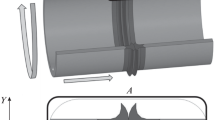Abstract
The structure of the contact lines and of the thermomechanically affected zone of welded joints of medium-carbon steels obtained by rotary friction welding have been studied using metallography and scanning electron microscopy supplemented with X-ray electron microprobe analysis. The results of the microhardness distribution over the cross section of the welded joint are presented. The phase transformations realized at each stage of the technological process of welding in the regions subjected to the thermodeformation influence have been analyzed. The results of the uniaxial tensile and impact bending tests supplemented by the fractography of the fracture surface are presented.






Similar content being viewed by others
REFERENCES
A. F. Vavilov and V. P. Voinov, Friction Welding (Mashinostroenie, Moscow, 1964) [in Russian].
A. M. Khusnullin and R. M. Kashaev, “Control of linear friction welding,” Pis’ma o Materialakh 6, No. 3, 227–230 (2016).
E. V. Sergeeva, “Friction stir welding in the aerospace industry (review)” Avtomaticheskaya Svarka, No. 5, 58–62 (2013).
Friction Stir Welding and Processing, Ed. by R. S. Misha and M. W. Mahoney (San Francisco, 2005).
V. V. Krasil’nikov, E. R. Shagabutdinov, M. E. Kuznetsov, I. V. Borodulin, and V. V. Karatysh, “The friction stir spot welding by lap joint with separation of the weld cycle,” Master’s J., No. 1, 48–53 (2015).
Yu. V. Klimenko, USSR Inventor’s Certificate No. 195846 (9 November 1965).
V. I. Vil’, Friction Welding of Metals (Mashinostroenie, Moscow, 1970) [in Russian].
V. K. Lebedev, I. A. Chernenko, V. I. Vill’ et al., Friction Welding: Handbook (Mashinostroenie, Leningrad, 1987), p. 236 [in Russian].
M. Sahin, “Joining with friction welding of high-speed steel and medium-carbon steel,” J. Mater. Process. Technol. 168, 202–210 (2005). https://doi.org/10.1016/j.jmatprotec.2004.11.015
M. Sahin, “Characterization of properties in plastically deformed austenitic-stainless steels joined by friction welding,” Mater. Des. 30, 135–144 (2009). https://doi.org/10.1016/j.matdes.2008.04.033
M. Sahin, “Evaluation of the joint-interface properties of austenitic-stainless steels (AISI 304) joined by friction welding,” Mater. Des. 28, 2244–2250 (2007). https://doi.org/10.1016/j.matdes.2006.05.031
N. O. Zdemira, F. Sarsılmaz, and A. Hascalık, “Effect of rotational speed on the interface properties of friction-welded AISI 304L to 4340 steel,” Mater. Des. 28, 301–307 (2007). https://doi.org/10.1016/j.matdes.2005.06.011
K. Umanath, K. Palanikumar, and K. Vigneswar, “The microhardness analysis of friction welded AISI 52100 grade carbon steel joints,” Adv. Mater. Res. 984–985, 613–617 (2014). 10.4028/www.scientific.net/AMR.984-985.613
V. V. Satyanarayana, R. G. Madhusudhan, and T. Mohandas, “Dissimilar metal friction welding of austenitic–ferritic stainless steels,” J. Mater. Process. Technol. 160, 128–137 (2005). https://doi.org/10.1016/j.jmatprotec.2004.05.017
N. S. Kalsi and V. S. Sharma, “A statistical analysis of rotary friction welding of steel with varying carbon in workpieces,” Int. J. Adv. Manuf. Technol. (2011). https://doi.org/10.1007/s00170-011-3361-z
S. Rao A and Y. Naik, “Comparison of appearance, microstructure and tensile properties during friction stir welding processes of Al–Si alloys,” Phys. Met. Metallogr. 118, 716–722 (2017).
A. A. Chularis, R. A. Rzaev, and A. G. Valisheva, “Evolution of mechanisms of plastic strain responsible for structure formation in near-weld zone under friction stir welding,” Metallovedenie i Termich. Obr. Metallov, No. 1, 54–60 (2019).
S. S. Gorelik, S. V. Dobatkin, and L. M. Kaputkina, Recrystallization of Metals and Alloys (MISIS, Moscow, 2005) [in Russian].
M. V. Degtyarev, L. M. Voronova, T. I. Chashchukhina, V. P. Pilyugin, and N. N. Resnina, “Evolution of the nickel structure during deformation by shear under high pressure at 150°C,” Phys. Met. Metallogr. 118, No. 3, 256–263 (2017).
L. N. Larikov, V. R. Ryabov, and V. M. Fal’chenko, Diffusion Processes in Solid Phase during Welding (Mashinostroenie, Moscow, 1975) [in Russian].
Funding
This work was performed within the framework of the state task of the Ministry of Education and Science of the Russian Federation according to the theme “Struktura,” no. АААА-А18-118020190116-6.
Author information
Authors and Affiliations
Corresponding author
Additional information
Translated by G. Salnikov
Rights and permissions
About this article
Cite this article
Priymak, E.Y., Yakovleva, I.L., Tereshchenko, N.A. et al. Evolution of the Structure and Mechanism of the Formation of Welded Joints of Medium-Carbon Steels upon Rotary Friction Welding. Phys. Metals Metallogr. 120, 1091–1096 (2019). https://doi.org/10.1134/S0031918X19110127
Received:
Revised:
Accepted:
Published:
Issue Date:
DOI: https://doi.org/10.1134/S0031918X19110127




